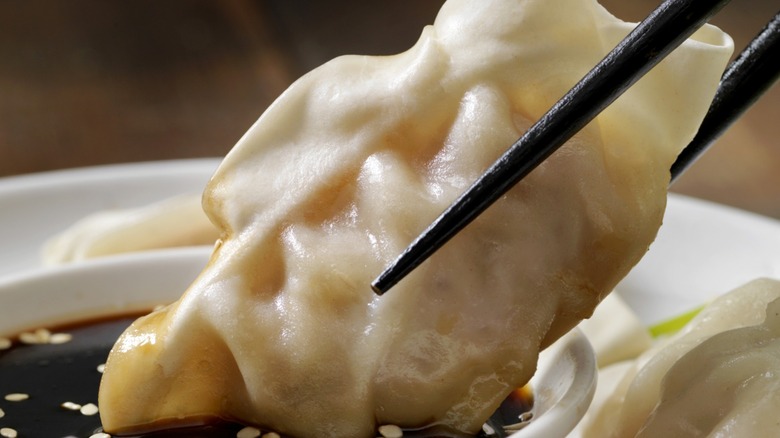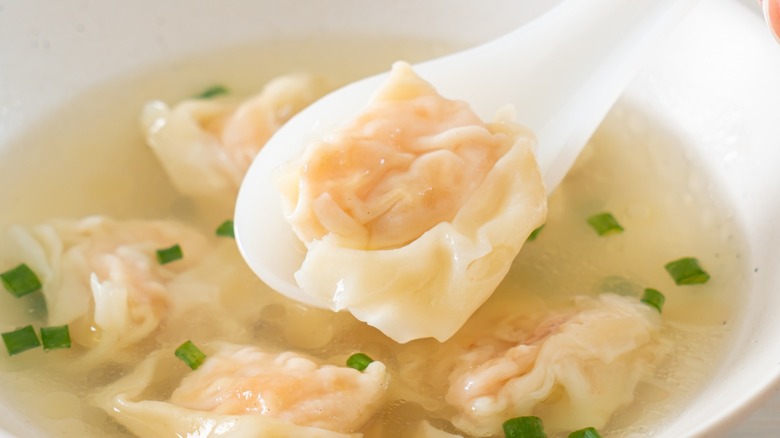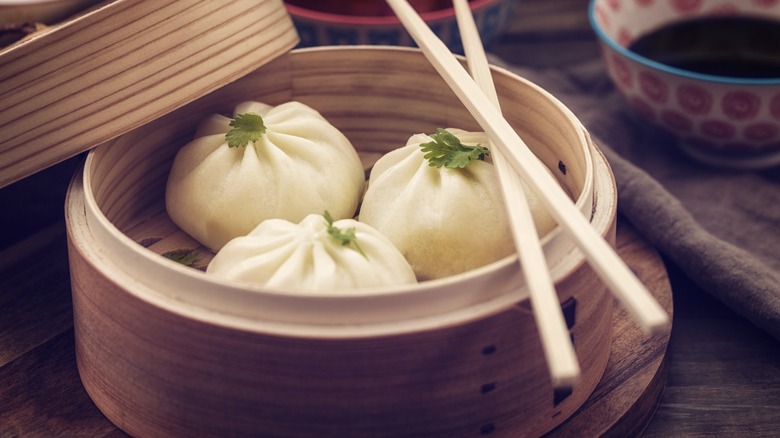Boiled Dumplings Vs Steamed: What's The Texture Difference?
A bag of frozen Chinese dumplings needs to be part of everybody's essential kitchen supplies. You can take them out of the freezer whenever you need something tasty, filling, and relatively quick to prepare, whether it's just for a snack or a meal. But naturally, to make your home-cooked dumplings taste as good as what you would get from a restaurant, you must know how to cook them well in the style you prefer.
The three basic ways of preparing dumplings are pan-frying, steaming, and boiling. The results of the first method are easy to spot: a dumpling with a bottom that has turned golden and crispy from pan-searing that is still juicy and pillowy up top and on the inside. Pan-fried dumplings are also called potstickers. The latter two, however, yield dumplings that are not so easy to tell apart at a glance. But just because neither method presents telltale marks doesn't mean you can swap one for the other.
Preferring steaming over boiling (or the other way around) is a matter of personal taste, but you should also consider the type of dumpling you will be cooking. The shape of the dumpling, the thickness of its wrapper, and how it is sealed are all factors that you must consider when deciding how to cook it best since each method applies its own heat and pressure to these delicacies. This affects the texture and flavor of the food, and, subsequently, your enjoyment of it.
Boiling turns dumplings soft and juicy
Boiling is the simplest method of cooking dumplings. However, it takes more time since it involves waiting for the water to boil before adding the dumplings in and then letting everything reach the boiling point again. While this method is great for making a big batch of food, you need to be careful not to overcook the pieces. Some home cooks even recommend adding a quarter of a cup of cold water once the pot starts boiling again with the dumplings in it. This helps moderate the temperature and keeps the wrappers from becoming too starchy.
When done properly, this cooking method results in a dumpling with a wrapper that is soft and chewy but not mushy and a juicy and flavorful filling. Think of your favorite wonton soup where the wonton wrappers still have some bite to them instead of disintegrating in the mouth. Wontons work well with this cooking style because their wrappers can withstand the vigorous pressure of boiling water despite their thinness.
To keep the tender wrappers of these delicacies from rupturing, always follow the boiling instructions indicated on the package of your frozen store-bought dumplings. If you plan on creating homemade ones, use cold water when making the dough for their wrappers. This activates the flour to produce gluten, making them thicker and chewier. When sealing the dumplings, don't leave any air pockets inside or along the seams. This will keep them from bursting open during cooking.
Steaming leaves dumplings plump and firm
One of the most enjoyable parts of ordering steamed dumplings at a restaurant is that moment of anticipation when the bamboo steamer is about to be opened to reveal the puffy dumplings inside. Recreating this experience at home is easy (not to mention quicker than boiling) as long as you have a bamboo steamer insert that you can fit over a wok or a saucepan.
This cooking method yields dumplings with a wrapper that still feels silky but is firmer and more stretchy than those of boiled dumplings. A dumpling looks more plumped up, too, when it has been steamed. Store-bought variants also develop some transparency in their wrappers when cooked with a steamer. In terms of taste, the flavors of the fillings are brought out more since they retain their natural fats and oils rather than leaking them out into a pot of boiling water.
Steaming works well with most types of dumplings, from har gow to bao zi, so it's worth investing in a steamer set-up at home if you enjoy firmer and more flavorful dumplings. Remember not to crowd the steamer with too many pieces so each one has sufficient space to puff up. Also, make sure that you're not using too much water to create steam so that when it boils, it doesn't reach the dumplings. When making homemade dumplings that you plan to cook this way, use hot (not just warm) water with the flour to create a wrapper that you can stretch and roll into soft and supple sheets.


